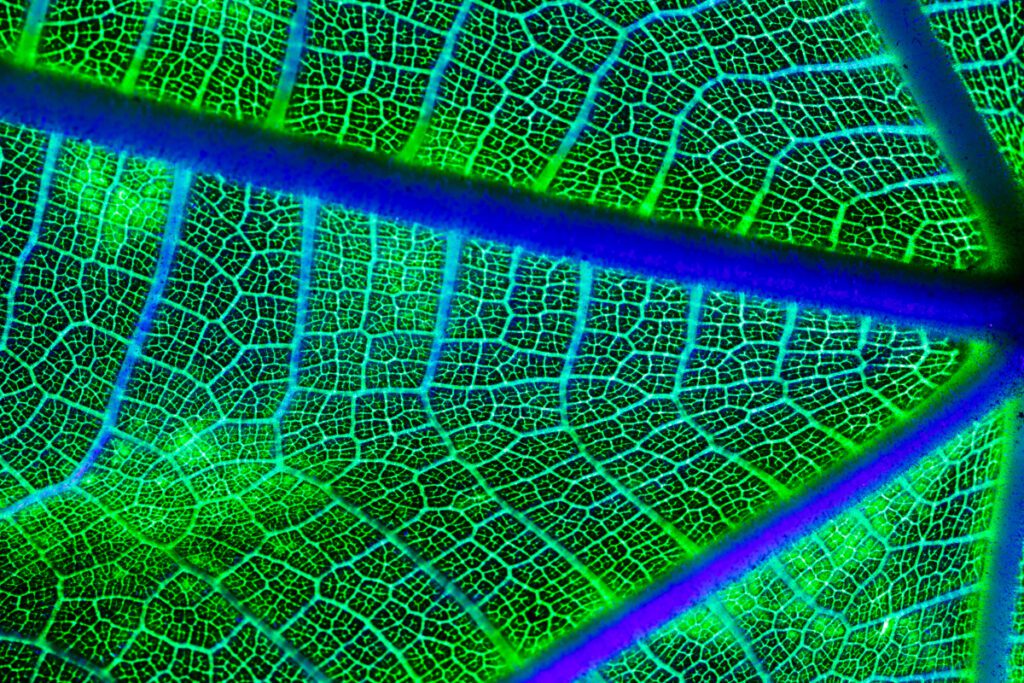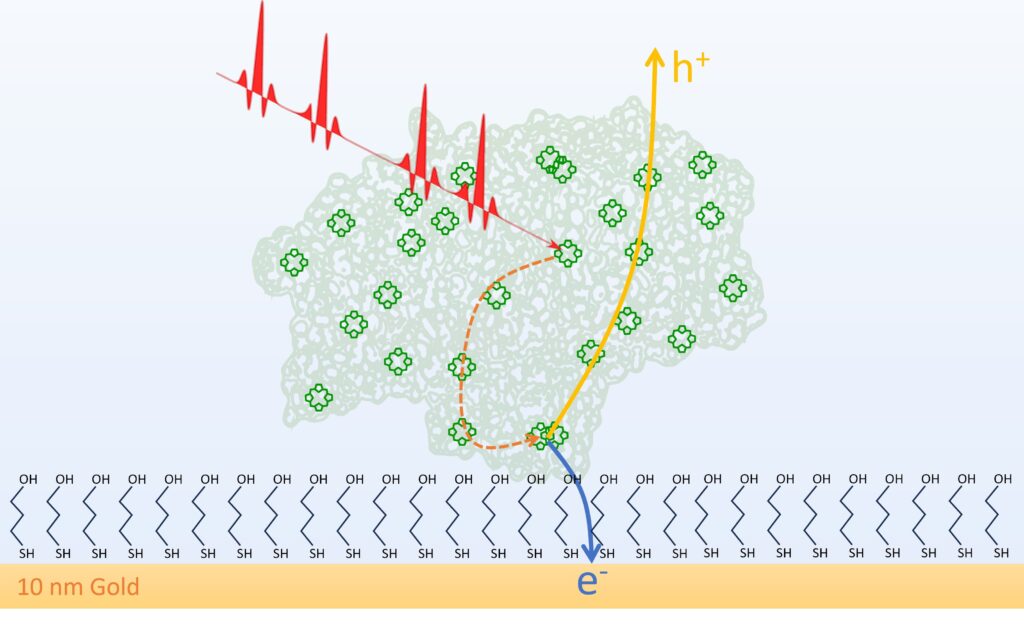A team of researchers led by IBEC and ICFO has developed and validated a novel photoelectrochemical electron spectroscopy technique to probe charge separation dynamics, a crucial step for photosynthesis, in photosynthetic complexes.

Photosynthesis is the process by which some organisms (for instance, plants, algae and some bacteria) transform light energy into chemical energy. This process begins with the absorption of light (photons) by certain pigments (mainly chlorophyll) and ends with a flow of electrons that sustain the biochemical reactions that make life on Earth possible.
One intermediate step that has not been directly probed yet, mainly because it occurs at ultrafast timescales, is the so-called charge separation. Once the pigment absorbs a photon, an electron is excited to a higher energy level. This extra energy is then transferred to specific locations, called reaction centers, causing an electron of the chlorophyll in those centers to be again excited and transferred to another complex (the acceptor molecule). Consequently, the chlorophyll becomes positively charged, which means that charge separation has occurred. This charge difference is crucial because it sets up a flow of high-energy electrons that will drive the rest of the photosynthetic process.
I think our results are very significant because we have provided a new way to directly access the biologically relevant charge separation processes, which are crucial for understanding photosynthesis.
Luca Bolzonello
To decipher photosynthetic complexes and engineer novel photosynthetic strategies, it is thus key to probe the pathways leading to charge separation. This phenomenon has recently been tackled in a joint work between IBEC and ICFO researchers, also in collaboration with the University of Padua and Vrije Universiteit Amsterdam. The team has developed and validated a novel Photoelectrochemical Two-Dimensional Electronic Spectroscopy (PEC2DES) technique, which allows for the direct probing of charge separation dynamics in photosynthetic complexes. Their method was presented in ACS Applied Materials and Interfaces.
According to the researchers, the discovery could be used in biohybrid devices and sensors that rely on the precise control and understanding of electron transfer processes within complex protein assemblies. Dr. Luca Bolzonello, ICFO researcher and co-first author of the article, further guesses that one of the promising applications of PEC2DES could be “the design and optimization of artificial photosynthetic systems, which in turn could improve solar energy conversion efficiency.”
“I think our results are very significant because we have provided a new way to directly access the biologically relevant charge separation processes, which are crucial for understanding photosynthesis”, remarks Bolzonello.
Unlike traditional optical methods, PEC2DES uniquely combines photoelectrochemical detection (PEC) with nonlinear spectroscopy (2DES), allowing for the selective investigation of the charge separation event and offering insights into the excitation and charge transfer dynamics within complex photosynthetic systems. More importantly, this technique can study the ultrafast dynamics of the excitons within the system just by reading out directly the product of the photosynthesis, that is, the electrical charges that move across the electron transport chain.
Combining PEC and 2DES to obtain PEC2DES
To validate their method, researchers employed photosystem complex I-light harvesting complex I (PSI-LHCI) as model system, where light harvesting by ‘antenna chlorophylls’ is used to drive charge separation in the reaction centre. “At IBEC, we’ve spent years studying how proteins exchange electrons, a fundamental process in cell metabolism. This knowledge helped us to develop a method to capture the electrons produced by the Photosystem I complex when it is illuminated.” says Manuel López, co-first author of the study, who recently defended his PhD thesis at IBEC.
At IBEC, we’ve spent years studying how proteins exchange electrons, a fundamental process in cell metabolism. This knowledge helped us to develop a method to capture the electrons produced by the Photosystem I complex when it is illuminated.
Manuel López
They first developed the photoelectrochemical setup (PEC) at IBEC to measure the current generated by the PSI-LHCI complexes. Then, they integrated this setup with a two-dimensional electronic spectroscopy (2DES) system at ICFO. As López explains: “The challenge of this project is not only to quantify the electric current generated by Photosystem I, but to do so with the precision needed to reveal the subtle processes of excitation migration between chlorophylls. With the current measurements, we aim to gain information on how excited chlorophylls transfer their energy to the reaction centre, where the excitation energy is converted into electrical charge pairs.” This unprecedented combination of PEC and 2DES led to the PEC2DES technique presented in their study, which for the first time quantified the charges generated by the interaction of photons in the pigments of a photosynthetic protein.
“The main obstacles we encountered were the need to maintain sample stability over long periods of time, which is required by the 2DES measurements, and the difficulty to interpret the PEC2DES signal”, recalls Bolzonello. “Even though we discovered that the technique is blind to some ultrafast features, we opened the path to solve the issues.”

Future perspectives: toward artificial photosynthetic systems
The team has just opened the door to tracking the ultrafast dynamics of charge separation processes with the PEC2DES technique. In the near future, they would like to refine their tool by identifying and minimizing the effects of incoherent mixing, an undesired phenomenon that contaminates the object of study, in this case, the charge separation dynamics. They also consider exploring the application of this technique to other photosynthetic complexes or aiming to artificial systems where the effect of incoherent mixing, the main limit of this new technique, is minimized.
This research was led by ICREA Research Professors Pau Gorostiza, Senior Researcher at IBEC, and Niek F. van Hulst, Senior Researcher at ICFO. It is also part of the Q-SPET project funded by the BIST Ignite programme, which aims to foster collaboration between researchers in the BIST community.
Referenced article:
Manuel López-Ortiz, Luca Bolzonello, Matteo Bruschi, Elisa Fresch, Elisabetta Collini, Chen Hu, Roberta Croce, Niek F. van Hulst, y Pau Gorostiza. Photoelectrochemical Two-Dimensional Electronic Spectroscopy (PEC2DES) of Photosystem I: Charge Separation Dynamics Hidden in a Multichromophoric Landscape. ACS Applied Materials & Interfaces (2024). DOI: 10.1021/acsami.4c03652





